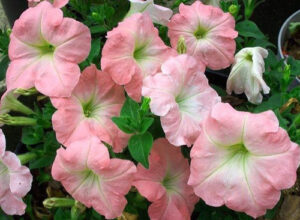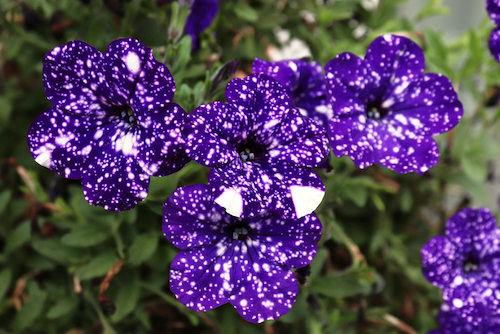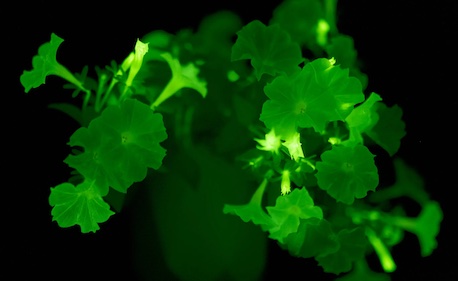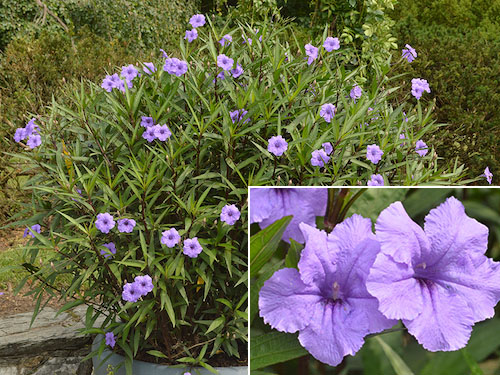Pretty as a Petunia
by Ray Novitske, Fairfax Master Gardener

Grandiflora Petunia ‘Celebrity Chiffon Morn’
We have all seen them, as they are one of the most popular annual flowers planted and available in nurseries and markets. They are incredibly varied in size, shape, color and pattern, and some have sweet fragrance. Some cultivars have ruffled large flowers, while others are double, star-patterned or even speckled. Some are great in containers, others for mounding on the ground. I have found certain types to my liking, but never knew the distinct differences beyond their appearance.
Petunias we see today are a distant relative from their native ancestors from temperate areas in South America. The common petunia (Petunia x hybrida) is a cross from many species from that region: P. axillaris, P. inflata and P. violaceae. The name is a derivative from the Brazilian name for tobacco. Petunias are members of the Solanaceae (or nightshade) family — the same as tobacco, potatoes, tomatoes and eggplant.

Multiflora Wave petunia ‘Red Velour’
Petunias are what is considered a low to medium maintenance plant. They love full sun but can survive on at least five to six hours. The more shade they get, the fewer flowers they produce. They prefer moist but well-drained soil, but not wet and soggy. Some do not do well in the heat and humidity of our area, especially older varieties, but newer cultivars can stand up to lots of heat. Rich soil is not required, but they do respond to a little fertilizer.
This plant is seldom attractive to deer. There are few serious pests because the modern petunias have been hybridized to resist a lot of diseases and pests. Some older varieties may be affected by botrytis rot and very extreme temperatures. Aphids, flea beetles, slugs and snails can be pest problems, while root rot, gray mold and tobacco mosaic virus are possible diseases.

Star pattern on ‘Amore Purple Hearts’ Petunia
Petunias have benefited from many breeding breakthroughs. The resulting different types can be divided into a few categories based on flower size and growth habit, each with different characteristics and requirements. Grandiflora (meaning “large-flowered”) petunias have the largest flowers. Ruffled petals and flowers measuring up to 4 inches (10 cm) in diameter with solid colors are common, as they are often used in landscaping and massing in the garden. Deadheading, or pinching off the old spent blossoms, encourages blooming by preventing seed formation.
Also, pinching them back encourages formation of side shoots, which will add more blooms. Grandiflora petunias also benefit from cutting them back to a few inches above their base to keep them from becoming leggy. Doing the same immediately after planting will help to maintain a busy habit. After cutting back, a shot of fertilizer will help rejuvenate them.
Multiflora (meaning “many-flowered”) petunias have somewhat smaller flowers, but in greater numbers than grandiflora. They generally also better tolerate weather extremes. Multiflora petunias have more striking petal colors and patterns and perform well in hanging baskets. Note that when planted in hanging baskets and containers, petunias often require more frequent watering. Deadheading is not necessary on the multiflora varieties and are noted for being “self-cleaning.”

Speckled pattern on “Night Sky’ petunia
Milliflora types are compact, miniature plants that produce abundant quantities of small flowers of 1 inch (3 cm) or less in diameter. Again, as with multiflora, pinching back is not necessary. They perform and display well in containers and window boxes and are very weather-tolerant.
Finally, spreading type petunias are noted for just that — spreading. They grow only about 6 inches (15 cm) in height but spread quickly to fill in large areas in a growing season. They are also noted for their weather tolerance. These are the newest cultivars and are perfect for containers and window boxes because they can bloom profusely and produce trails up to 2 or 3 feet long (60 to 100 cm).

‘Firefly’ petunia
The Supertunia series was the first really new variety that took off in the market. Its vigorous growth, excellent shape, weather-tolerance and numerous blooms appealed to many gardeners. They are also fond of fertilizer. The Wave series (Easy Wave, Tidal Wave, Shock Wave) were improvements that produced continuously blooming plants throughout the summer without any need to trim back. These are spreading types. The Morn series is very new milliform series and is characterized by very compact plants with very small blooms in great numbers.
Science has created and opened up new possibilities in plant breeding with the first glow-in-the-dark plant. Bio Light is the first company to offer its ‘Firefly’ Petunia to the marketplace. The company has genetically engineered a petunia by incorporating genes from a bioluminescent mushroom to produce a plant that glows in the dark. Its soft glow is similar to moonlight while showing off 8-inch (30 cm) white flowers during the day.

Ruella simplex ‘Mexican Petunia’
It must be noted that the Mexican Petunia or Wild Petunia with lavender flowers resembling petunias is not a petunia or related to it. Ruellia simplex is a member of the Acanthaceae family and is often used as an ornamental landscape plant in our area. It can grow to a woody shrub, 2 or 3 feet (60 to 100 cm) in height in more temperate areas where it is a perennial. Listed as an invasive species, its aggressive growth and its difficulty in eradication has displaced native flora. Mexican petunia will grow in high heat and humidity, has no serious insect or disease problems and tolerates wet or dry soils.
If looking for an annual that blooms continuously throughout the summer until frost, consider one of the hundreds of petunia cultivars that have been developed.
- References
- Growing Petunias, Deborah Brown revised by Kristine Moncada, University of Minnesota Extension
- Petunia x hybrida, North Carolina State University Extension
- Petunia: Better Than Ever, University of Missouri
- Petunias, University of Florida
- Ruellia simplex, North Carolina State University Extension